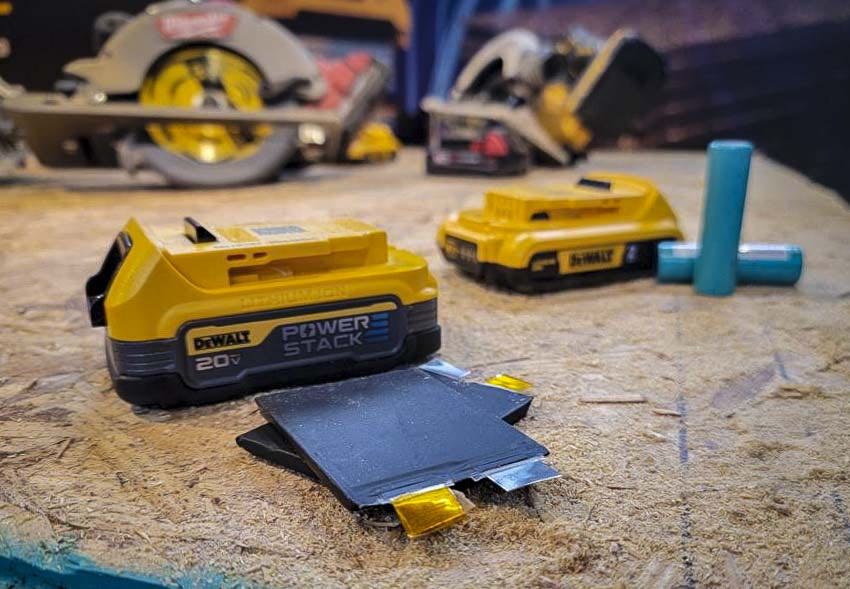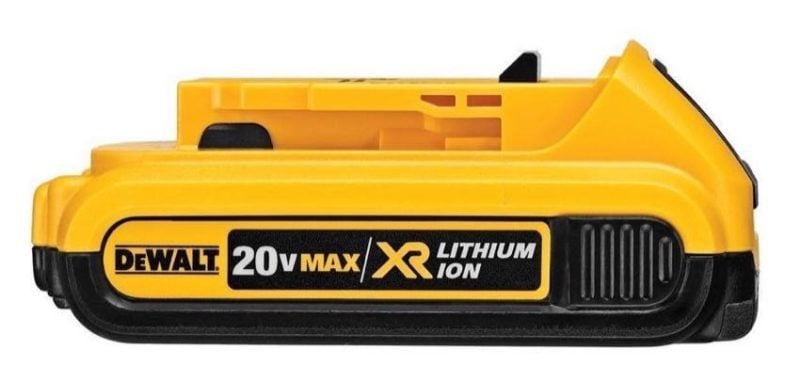Designed with stacked pouch battery cells instead of cylindrical cells, DeWalt PowerStack 20V Max batteries make some huge changes. DeWalt claims PowerStack batteries and technology provide more power with less weight and size. They give the case in point with their debut model, the DeWalt DCBP034 PowerStack 1.7Ah battery.
This might be the biggest announcement made since DeWalt Tool Connect came online. DeWalt also seems to be the first major power tool brand to use pouch cell batteries in the construction industry.
UPDATE: DeWalt PowerStack Vs DeWalt 2.0Ah Battery Tested
We were able to test the DeWalt PowerStack battery against the standard 20V Max 2.0Ah battery and the results were telling.
We started with the DCF850 impact driver setting 8-inch GRK Fasteners RSS screws into stacked OSB. We also tested a 5.0Ah battery to see how it compares. Here are the results:
| 20V Max PowerStack | 20V Max 2.0Ah | 20V Max 5.0Ah | |
| Test 1 | 11.43 sec | 15.46 sec | 10.28 sec |
| Test 2 | 11.62 sec | 16.24 sec | 10.22 sec |
| Test 3 | 13.19 sec | 11.42 sec | 9.28 sec |
| Test 4 | 9.75 sec | 11.70 sec | 10.14 sec |
| Test 5 | 10.14sec | 12.22 sec | 10.69 sec |
| Average | 11.23 sec | 13.41 sec | 10.12 sec |
Clearly, PowerStack has an advantage in this test. It’s not quite as strong as the much larger 5.0Ah battery, though. We decided to take it a step further and shifted to the DCD797 compact hammer drill with a 3/4-inch auger bit in double-stacked 2×4 studs.
In high speed, the PowerStack battery did just fine, averaging 2.25 seconds. The 2.0Ah battery was only able to complete one hole in high speed and failed on the other four. That’s a solid result in itself, but we flipped the drill into low gear just to see what time differences there were.
| 20V Max PowerStack | 20V Max 2.0Ah | |
| Test 1 | 4.68 sec | 5.16 sec |
| Test 2 | 4.57 sec | 5.44 sec |
| Test 3 | 4.61 sec | 5.35 sec |
| Test 4 | 4.51 sec | 5.11 sec |
| Test 5 | 4.59 sec | 4.91 sec |
| Average | 4.59 sec | 5.19 sec |
If there was any doubt remaining, this final test sealed the deal. You clearly get better performance from a DeWalt PowerStack battery than the standard 2.0Ah compact pack. You give up a little capacity. But then again, you get the work done quicker, which may very well even out the runtime.
DeWalt PowerStack Technology Overview
The big deal behind DeWalt PowerStack batteries is the use of stacked lithium-ion polymer pouches instead of cylindrical cells. While current 20V Max batteries use either 18650 or 21700 cells, PowerStack uses a literal “stack” of 5 lithium-polymer pouches.

When using stacking technology, you gain the advantages of less internal resistance, longer life, and better utilization of internal space.

That means you can make the packs smaller with the same amount of power output. This high energy density, of course, also lets you choose to occupy the same space while providing even more power. Because you have the potential for greater energy density and more life cycles, stacked cell batteries offer a lot of hard-to-ignore advantages.

Bold Claims
According to DeWalt, their 1.7Ah DCBP034 Powerstack battery provides 50% more power than their 2.0Ah DCB203 in a 25% more compact housing. DeWalt also claims 2X the charge cycles compared to the 18650 cell-based DCB203 compact 20V Max battery.

More power, more compact, and more charge cycles? You can bet we’ll see a lot more stacked cell batteries in the near future.
DeWalt PowerStack DCBP034 vs DCB203 Compact Battery Specs
When comparing the 20V Max DeWalt PowerStack DCB034 vs the DCB203 Compact battery we want to look at weight, size, and capacity. Here’s what we know:
| DCBP034 | DCB203 | |
|---|---|---|
| Capacity (Ah) | 1.7 Ah | 2.0 Ah |
| Capacity (Wh) | 30.6 Wh | 36 Wh |
| Length | 4.1 in. | 4.625 in. |
| Width | 2.5 in. | 2.95 in. |
| Height | 1.7 in. | 1.875 in |
| Weight | 0.7 lbs. | 0.8 lbs. |
| Charge Cycles (estimated) | 1000 | 500 |
| Price | TBD | $99 |
The first thing we noted was the apparently lower Ah and Wh rating of the pack. What has us perplexed is how a 1.7Ah pack is “50% more powerful” than a 2.0Ah pack. We’ll have to learn more about how these numbers translate into real-world results after we get our hands on some of these new DeWalt PowerStack batteries.

Size Does Matter
The real big deal—aside from energy output—has to be the size. These new packs offer a lot more power density, which means you get more power in less space. The specs above form some of the total picture. Perhaps these photos can help show the key difference in both length and width:

DeWalt DCB203 
DeWalt DCBP034 PowerStack 
DCB203 2.0Ah pack 
DCBP034 1.7Ah pack
DeWalt PowerStack Battery Pricing and Availability
Fortunately, DeWalt gave us pricing on the new PowerStack battery pack as well as some available configurations. For now, DeWalt has three options for their new batteries with PowerStack technology:
- DCBP034 Compact Battery – $119
- DCBP034C Compact Battery Starter Kit with DCB112 Charger – $149
- DCBP034-2 (2-pack) – $179
The DeWalt PowerStack 20V Max Compact Battery (DCBP034) begins rolling out in North America starting December 1, 2021. DeWalt then plans to continue its global debut of the technology through Spring of 2022. Look for DeWalt PowerStack batteries to arrive as a parallel premium option alongside existing 20V compact batteries.
Final Thoughts
DeWalt couched their comments to specs when talking about power, citing “not in application” when talking about power. We really look forward to understanding how stacked polymer “pouch” style batteries fare in real-world testing. From what we’ve experienced so far, these packs should put out more power while saving on bulk and weight.
The limiting factor does indeed appear to be runtime. When DeWalt manages to release packs with larger amp-hours remains to be seen—that will take the power and add additional runtime.
Traditionally, pouch cell batteries tend to swell with gas during charge and discharge cycles (with as much as a 10% increase in volume). Hopefully, the engineering behind DeWalt PowerStack batteries accommodates or solves this expansion and contraction issue.
The increased number of charge cycles really impresses us. That can’t be overstated as it means your packs last longer—and that translates into real savings.
Get more information from the DeWalt website.








I suspect that cells in the old style batteries are lipos because that is the only battery chemistry I have heard having a 500 cycle limit. The new prismatic stacked cells have a 1000 cycle limit. I know prismatic cells are popular for the LIFEPO4 chemistry and that chemistry has a 2000-4000 cycle limit. But there are other chemistries out there similar to LIFEPO4. But powerstack could be just rated at 1000 to be conservative, they don’t really know what these will do out in the field yet and they may be playing it safe. They absolutely went in the… Read more »
I bought the power stack happy with it for a short term but compared to the 5H are the 4H definitely not the same if you’re a contractor or handyman you can buy the power stack for a little jobs but for big jobs you’re gonna want your 4H5H or 6H I wish I would’ve bought two of the 5H versus the power stack but now I’m stuck with them sometime and smaller isn’t better
does this new Power stack battery work well with a 20V Max XR?
What your review didn’t take into consideration was deterioration of the contents over time or shelf life. Will the battery perform and take charges in year two or three and come to a complete sustainable charge as it did new or does the battery strength diminish. You say it takes 1000 charges vs 500, but are those charges reflective as the battery ages?
As a dealer, powerstack “looks” like a sales gimmick to me and not a serious advantage over the competitors. Won’t be switching immediately.